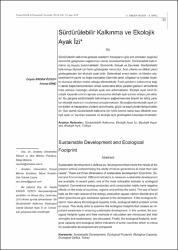| dc.contributor.author | Özsoy, Ceyda Erden | |
| dc.contributor.author | Dinç, Ahmet | |
| dc.date.accessioned | 2019-10-20T21:12:43Z | |
| dc.date.available | 2019-10-20T21:12:43Z | |
| dc.date.issued | 2016 | |
| dc.identifier.issn | 1307-7112 | |
| dc.identifier.uri | http://www.trdizin.gov.tr/publication/paper/detail/TWpBNE16YzFOUT09 | |
| dc.identifier.uri | https://hdl.handle.net/11421/19077 | |
| dc.description.abstract | Sürdürülebilir kalkınma gelecek nesillerin ihtiyaçlarını göz ardı etmeden bugünkü ekonomik gelişmenin sağlanması olarak tanımlanmaktadır. Sürdürülebilir kalkınmanın üç boyutu bulunmaktadır: Ekonomik, Sosyal ve Çevresel. Sürdürülebilir kalkınmayı ölçmek için farklı göstergeler mevcuttur. Son yıllarda en dikkat çekici göstergelerden biri ekolojik ayak izidir. Geleneksel enerji üretim ve tüketim alışkanlıklarının çevre ve doğal kaynaklar üzerinde yerel, bölgesel ve küresel ölçekte olumsuz etkilere neden olduğu bilinmektedir. Fosil yakıtların kullanımına bağlı olarak başta karbondioksit olmak üzere sera etkisi yaratan gazların atmosferde hızla artması insanlığın ekolojik ayak izini arttırmaktadır. Ekolojik ayak izinin biyolojik kapasite sınırını aşması sonucunda ekolojik açık sorunu ortaya çıkmaktadır. Bu çalışma sürdürülebilir kalkınmanın sağlanmasında önemli bir bilinç yaratan ekolojik ayak izini incelemeyi amaçlamaktadır. Bu bağlamda ekolojik ayak izinin türleri ve hesaplama yöntemi tanıtılmakta, güçlü ve zayıf yönleri tartışılmaktadır. Son olarak sürdürülebilir kalkınma için kritik öneme sahip bazı ülkelerin ekolojik ayak izi, biyolojik kapasite ve ekolojik açık göstergeleri karşılaştırılmaktadır. | en_US |
| dc.description.abstract | Sustainable development is defined as "development that meets the needs of the present without compromising the ability of future generations to meet their own needs". There are three dimensions of sustainable development: Economic, Social and Environmental. Different indicators to measure sustainable development are available. In recent years, one of the most noticeable indicator is ecological footprint. Conventional energy production and consumption habits have negative effects on the scale of countries, regions and entirely the world. The use of fossil fuels as the main source of the energy production causes carbon dioxide and all other greenhouse gas emissions spread in the atmosphere. If the ecological footprint rises above the biological capacity limits, ecological deficit problem will be an issue. This study aims to examine the ecological footprint that creates an important awareness in ensuring sustainable development. In this context, the ecological footprint types and their methods of calculation are introduced and their strengths and weaknesses are discussed. Finally, the ecological footprint, biological capacity and ecological deficit indicators of some countries which is critical for sustainable development are compared. | en_US |
| dc.language.iso | tur | en_US |
| dc.rights | info:eu-repo/semantics/openAccess | en_US |
| dc.subject | İktisat | en_US |
| dc.subject | İşletme Finans | en_US |
| dc.title | Sürdürülebilir Kalkınma ve Ekolojik Ayak İzi | en_US |
| dc.title.alternative | Sustainable Development and Ecological Footprint | en_US |
| dc.type | article | en_US |
| dc.relation.journal | Finans Politik ve Ekonomik Yorumlar Dergisi | en_US |
| dc.contributor.department | Anadolu Üniversitesi, İktisadi ve İdari Bilimler Fakültesi, İktisat Bölümü | en_US |
| dc.identifier.volume | 53 | en_US |
| dc.identifier.issue | 619 | en_US |
| dc.identifier.startpage | 35 | en_US |
| dc.identifier.endpage | 56 | en_US |
| dc.relation.publicationcategory | Makale - Ulusal Hakemli Dergi - Kurum Öğretim Elemanı | en_US] |


















